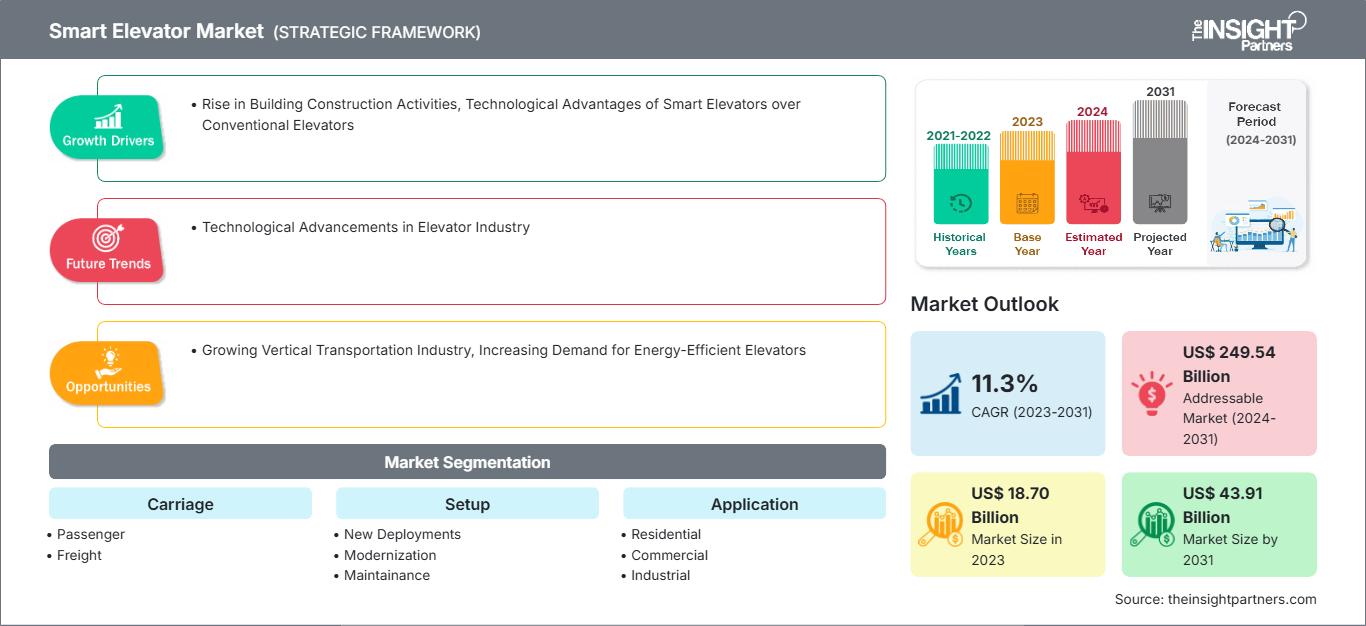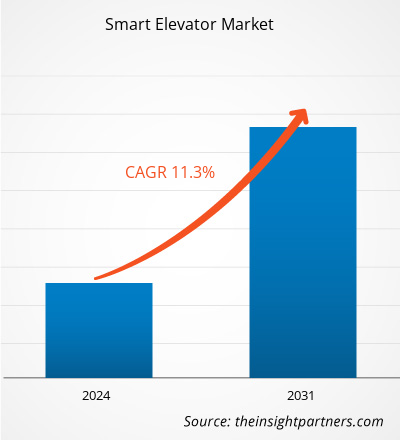스마트 엘리베이터 시장은 2023년 187억 달러에서 2031년 439억 1천만 달러로 성장할 것으로 예상됩니다. 2023년부터 2031년까지 연평균 성장률(CAGR) 11.3%를 기록할 것으로 예상됩니다. 예측 기간 동안 스마트 엘리베이터 시장의 주요 트렌드는 기술 발전과 신기술 도입입니다.
스마트 엘리베이터 시장 분석
기존 엘리베이터와 달리 스마트 엘리베이터는 얼굴 인식, 생체 인식 및 기타 기술과 같은 혁신적인 보안 수단을 사용하여 무단 출입을 방지합니다. 또한, 스마트 엘리베이터는 과도한 진동, 전기적 결함 등 엘리베이터의 비정상적인 작동을 지속적으로 모니터링하는 센서 및 기타 시스템을 통합합니다. 따라서 예측 기간 동안 스마트 엘리베이터에 대한 수요가 증가할 것으로 예상됩니다.
스마트 엘리베이터 시장 개요
스마트 엘리베이터에는 인공지능(AI), 사물 인터넷(IoT), 클라우드 컴퓨팅, 하드웨어 및 소프트웨어와 같은 최신 기술이 탑재되어 있습니다. 이러한 시스템을 통해 상태 기반 분석, 사전 예방적 실시간 데이터 공유, 예측 유지 관리, 강화된 보안, 목적지 예측 및 기타 기능이 제공됩니다. 스마트 엘리베이터는 사용자 친화적이고 에너지 효율적이며 안전하고 보안성이 뛰어나며 가동 중단 시간을 최소화합니다. 화물 및 승객용 엘리베이터 시스템은 스마트 기능을 갖추고 있지만, 스마트 화물 엘리베이터에는 향상된 내부 디자인, 인포테인먼트 시스템 및 기타 정밀 승객 기능이 없습니다.
스마트 엘리베이터 시장 성장 동력 및 기회
요구 사항에 맞게 이 보고서를 사용자 정의하십시오.
이 보고서의 일부, 국가 수준 분석, Excel 데이터 팩을 포함하여 모든 보고서에 대한 사용자 정의를 무료로 받을 수 있을 뿐만 아니라 스타트업 및 대학을 위한 훌륭한 제안 및 할인을 이용할 수 있습니다
스마트 엘리베이터 시장: 전략적 통찰력

- 이 보고서의 주요 주요 시장 동향을 확인하세요.이 무료 샘플에는 시장 동향부터 추정 및 예측에 이르기까지 데이터 분석이 포함됩니다.
이 보고서의 일부, 국가 수준 분석, Excel 데이터 팩을 포함하여 모든 보고서에 대한 사용자 정의를 무료로 받을 수 있을 뿐만 아니라 스타트업 및 대학을 위한 훌륭한 제안 및 할인을 이용할 수 있습니다
스마트 엘리베이터 시장: 전략적 통찰력

- 이 보고서의 주요 주요 시장 동향을 확인하세요.이 무료 샘플에는 시장 동향부터 추정 및 예측에 이르기까지 데이터 분석이 포함됩니다.
건물 건설 증가 및 친환경 건물 수요 증가로 시장 호조세 예상
건물 건설 증가와 친환경 건물 수요 증가는 스마트 엘리베이터 시장 성장의 주요 동력입니다. 또한, 스마트 엘리베이터 수요 증가는 기존 엘리베이터와 차별화되는 여러 가지 특징에 기인합니다. 기존 엘리베이터는 기본적인 컴퓨팅 성능으로는 사용자의 대기 시간을 단축할 수 없어 비효율적입니다. 또한, 최신 엘리베이터에 비해 에너지 효율이 낮고 엘리베이터 시스템의 실시간 모니터링 기능도 없습니다. 반면, 스마트 엘리베이터는 기술적으로 진보되어 있으며 다양한 기능을 갖추고 있어 건설업체에서 활용도가 높습니다. 스마트 엘리베이터에 자율 시스템을 적용하면 엘리베이터 작동을 최적화하여 대기 시간을 단축하고, 궁극적으로 혼잡 시간대에 효율적인 승객 수송을 가능하게 합니다. 따라서 예측 기간 동안 스마트 엘리베이터에 대한 수요가 증가할 것으로 예상됩니다.
스마트 엘리베이터 시장 보고서 세분화 분석
"스마트 엘리베이터 분석"은 설치, 운송, 적용, 지리적 위치라는 세 부문을 고려하여 수행되었습니다.
- 설치 기준으로 스마트 엘리베이터 시장은 현대화, 신규 배치, 유지보수로 구분됩니다. 2022년에는 현대화 부문이 매출 측면에서 시장 점유율을 주도했으며, 유지보수 부문은 예측 기간 동안 상당한 연평균 성장률(CAGR)을 기록할 것으로 예상됩니다. 현대화 부문은 기존 엘리베이터 시스템에 새로운 시스템을 설치하여 시스템을 개선하는 것을 포함합니다. 시간이 지남에 따라 건물 관련 법률 및 기술 지침이 수정될 가능성이 높으므로 엘리베이터를 포함한 수많은 편의시설의 현대화가 필요합니다. 현대화 서비스를 통해 기존 엘리베이터는 클라우드 기반 예측 유지보수 솔루션, 실시간 모니터링, 향상된 사용자 인터페이스 및 인포테인먼트 시스템, 강화된 보안 등의 기능을 제공합니다.
- 또한 유지보수 부문은 건물 내 기존 엘리베이터의 유지보수를 포함합니다. 스마트 엘리베이터의 정기적인 유지보수는 엘리베이터의 수명을 연장하고 예기치 않은 고장을 방지합니다.
- 스마트 엘리베이터 시장은 운송 수단별로 승객용과 화물용으로 구분됩니다. 용도별로는 주거용, 상업용, 산업용으로 세분화됩니다.
지역별 스마트 엘리베이터 시장 점유율 분석
스마트 엘리베이터 시장 보고서의 지리적 범위는 주로 북미, 아시아 태평양, 유럽, 중동 및 아프리카, 중남미의 5개 지역으로 나뉩니다.
2022년에는 북미가 스마트 엘리베이터 시장 점유율 1위를 차지했습니다. 그러나 아시아 태평양 지역은 예측 기간 동안 가장 높은 CAGR을 기록할 것으로 예상됩니다. 미국과 캐나다는 높은 도시 생활 수준을 가진 부유한 국가입니다. 더욱이, 모든 비산업 및 산업 부문에서 새롭고 최신 기술의 도입 속도가 세계 다른 지역에 비해 상대적으로 높아 건물용 엘리베이터 수요가 증가할 것으로 예상됩니다. 새로운 건물 건설과 더 많은 고층 빌딩의 공급은 북미 지역의 신규 설치 부문, 현대화 및 유지보수 부문에서 스마트 엘리베이터 시장 성장을 촉진하는 데 중요한 역할을 하고 있습니다. 아시아 태평양 지역의 높은 연평균 성장률(CAGR)은 인도, 중국, 인도네시아, 베트남과 같은 국가의 폭넓은 경제 성장과 도시화 및 인구 증가에 기인합니다. 세계 인구는 지난 몇 년 동안 크게 증가했으며 앞으로 몇 년 동안 빠르게 증가할 것으로 예상됩니다. 유엔 예측에 따르면, 2022년 말 전 세계 인구는 80억 명에 달했으며, 2030년에는 85억 명으로 증가할 것으로 예상됩니다. 또한 2050년에는 97억 명에 이를 것으로 전망됩니다. 아프리카와 아시아, 특히 중국과 인도와 같은 국가들은 향후 30년간 도시화 증가에 크게 기여할 것으로 예상됩니다. 이러한 요인들은 향후 몇 년간 스마트 엘리베이터 시장 전망에 상당한 영향을 미칠 것으로 예상됩니다.
스마트 엘리베이터 시장 뉴스 및 최근 동향
스마트 엘리베이터 시장은 1차 및 2차 조사 이후 주요 기업 간행물, 협회 데이터, 데이터베이스 등 정성적 및 정량적 데이터를 수집하여 평가합니다. 다음은 시장 동향 목록입니다.
- 2022년 12월, 오티스는 엘리베이터 성능 기능을 24시간 실시간으로 추적하는 새로운 Gen3 스마트 엘리베이터 출시를 발표했습니다. (출처: 오티스 코퍼레이션, 보도자료)
스마트 엘리베이터 시장 지역별 분석
The Insight Partners의 분석가들은 예측 기간 동안 스마트 엘리베이터 시장에 영향을 미치는 지역별 동향과 요인들을 면밀히 분석했습니다. 이 섹션에서는 북미, 유럽, 아시아 태평양, 중동 및 아프리카, 그리고 중남미 지역의 스마트 엘리베이터 시장 세분화 및 지역별 분포도 살펴봅니다.
스마트 엘리베이터 시장 보고서 범위
| 보고서 속성 | 세부 |
|---|---|
| 시장 규모 2023 | US$ 18.70 Billion |
| 시장규모별 2031 | US$ 43.91 Billion |
| 글로벌 CAGR (2023 - 2031) | 11.3% |
| 이전 데이터 | 2021-2022 |
| 예측 기간 | 2024-2031 |
| 다루는 세그먼트 |
By 운송
|
| 포함된 지역 및 국가 | 북미
|
| 시장 선도 기업 및 주요 회사 프로필 |
|
스마트 엘리베이터 시장 참여자 밀도: 비즈니스 역학에 미치는 영향 이해
스마트 엘리베이터 시장은 소비자 선호도 변화, 기술 발전, 그리고 제품 이점에 대한 인식 제고 등의 요인으로 인한 최종 사용자 수요 증가에 힘입어 빠르게 성장하고 있습니다. 수요가 증가함에 따라 기업들은 제품 라인업을 확장하고, 소비자 니즈를 충족하기 위한 혁신을 추진하며, 새로운 트렌드를 적극 활용하고 있으며, 이는 시장 성장을 더욱 가속화하고 있습니다.

- 을 얻으세요 스마트 엘리베이터 시장 주요 주요 플레이어 개요
스마트 엘리베이터 시장 보고서 범위 및 제공 내용
“스마트 엘리베이터 시장 규모 및 예측(2023-2031)” 보고서는 아래 영역을 포괄하는 시장에 대한 자세한 분석을 제공합니다.
- 범위에 포함된 모든 주요 시장 부문에 대한 글로벌, 지역 및 국가 수준의 시장 규모 및 예측
- 동력, 제약 및 주요 기회와 같은 시장 역학
- 주요 미래 동향
- 상세한 PEST/포터의 5가지 힘 및 SWOT 분석
- 주요 시장 동향, 주요 업체, 규정 및 최근 시장 개발 내용을 포괄하는 글로벌 및 지역 시장 분석
- 시장 집중도, 히트맵 분석, 주요 업체 및 최근 개발 내용을 포괄하는 산업 환경 및 경쟁 분석
- 자세한 회사 프로필
- 과거 분석(2년), 기준 연도, CAGR을 포함한 예측(7년)
- PEST 및 SWOT 분석
- 시장 규모 가치/거래량 - 글로벌, 지역, 국가
- 산업 및 경쟁 환경
- Excel 데이터세트
최근 보고서
사용 후기
구매 이유
- 정보에 기반한 의사 결정
- 시장 역학 이해
- 경쟁 분석
- 고객 인사이트
- 시장 예측
- 위험 완화
- 전략 기획
- 투자 타당성 분석
- 신흥 시장 파악
- 마케팅 전략 강화
- 운영 효율성 향상
- 규제 동향에 발맞춰 대응




















 무료 샘플 받기 - 스마트 엘리베이터 시장
무료 샘플 받기 - 스마트 엘리베이터 시장